Sludge Dewatering and Mineralization in Sludge Treatment Reed Beds
Abstract
:1. Introduction
2. Sludge Treatment Reed Beds
2.1. System Design
2.2. System Operation
2.3. Plant Functions
3. Design and Operation Considerations
3.1. Design and Construction Issues
3.1.1. Too Few Beds
3.1.2. Damaged Drainage System
3.1.3. Wrong Composition of the Growth Layer
3.1.4. Wrong Planting Technique
3.2. Operation Issues
3.2.1. Wrong Running-In Period
3.2.2. Overloading
3.2.3. Lack of Resting Phases
3.3. Sludge Quality
- Mixing of sludge from an anaerobic digester with activated sludge prior to dewatering in the STRBs. This may result in a mixed sludge with a high oxygen demand that has difficult dewatering properties.
- The physical influence of using certain types of high-pressure pumps for transferring the activated sludge to the STRBs may disrupt floc structure and negatively impact dewatering.
- Transport of sludge in kilometer-long pipes with resulting long transport time, and/or storage of sludge prior to spreading on the surface of the reed beds has been shown to negatively affect sludge dewatering in the reed beds.
- Sludge from municipal wastewater treatment systems treating a significant fraction of industrial (including agro-industrial) wastewater has been shown to be difficult to dewater. Some studies indicate that the contents of fat in the sludge may be correlated with the dewatering difficulties [29].
- Addition of precipitation chemicals for phosphorus removal may influence dewatering properties.
4. Environmental Issues
4.1. Greenhouse Gas Emission
4.2. Pathogens
4.3. Organic Micro-Pollutants
4.4. Heavy Metals
5. Discussion
Acknowledgments
Conflicts of Interest
References
- Pescod, M.B. Wastewater Treatment and Use in Agriculture-Fao Irrigation and Drainage Paper 47; Food and Agriculture Organization of the United Nations: Rome, Italy, 1992. [Google Scholar]
- Uggetti, E.; Ferrer, I.; Llorens, E.; Garcia, J. Sludge treatment wetlands: A review on the state of the art. Bioresour. Technol. 2010, 101, 2905–2912. [Google Scholar] [CrossRef] [PubMed]
- Lasaridi, K.E.; Stentiford, E.I. A simple respirometric technique for assessing compost stability. Water Res. 1998, 32, 3717–3723. [Google Scholar] [CrossRef]
- Nielsen, S.M. Sludge dewatering and mineralisation in reed bed systems. In Constructed Wetlands in Water Pollution Control; Cooper, P.F., Findlater, B.C., Eds.; Pergamon Press: Oxford, UK, 1990; pp. 245–255. [Google Scholar]
- Uggetti, E.; Ferrer, I.; Nielsen, S.; Arias, C.; Brix, H.; Garcia, J. Characteristics of biosolids from sludge treatment wetlands for agricultural reuse. Ecol. Eng. 2012, 40, 210–216. [Google Scholar] [CrossRef]
- Matamoros, V.; Nguyen, L.X.; Arias, C.A.; Nielsen, S.; Laugen, M.M.; Brix, H. Musk fragrances, dehp and heavy metals in a 20 years old sludge treatment reed bed system. Water Res. 2012, 46, 3889–3896. [Google Scholar] [CrossRef] [PubMed]
- Nielsen, S. Sludge drying reed beds. Water Sci. Technol. 2003, 48, 101–109. [Google Scholar] [PubMed]
- Nielsen, S. Helsinge sludge reed bed system: Reduction of pathogenic microorganisms. Water Sci. Technol. 2007, 56, 175–182. [Google Scholar] [CrossRef] [PubMed]
- Nielsen, S.; Peruzzi, E.; Macci, C.; Doni, S.; Masciandaro, G. Stabilisation and mineralisation of sludge in reed bed systems after 10–20 years of operation. Water Sci. Technol. 2014, 69, 539–545. [Google Scholar] [CrossRef] [PubMed]
- Peruzzi, E.; Nielsen, S.; Macci, C.; Doni, S.; Iannelli, R.; Chiarugi, M.; Masciandaro, G. Organic matter stabilization in reed bed systems: Danish and italian examples. Water Sci. Technol. 2013, 68, 1888–1894. [Google Scholar] [CrossRef] [PubMed][Green Version]
- Nielsen, S. Sludge treatment and drying reed bed systems. Ecohydrol. Hydrobiol. 2007, 7, 223–234. [Google Scholar] [CrossRef]
- Nielsen, S.; Larsen, J.D. Operational strategy, economic and environmental performance of sludge treatment reed bed systems-based on 28 years of experience. Water Sci. Technol. 2016, 74, 1793–1799. [Google Scholar] [CrossRef] [PubMed]
- Nielsen, S.; Cooper, D.J. Dewatering sludge originating in water treatment works in reed bed systems. Water Sci. Technol. 2011, 64, 361–366. [Google Scholar] [CrossRef] [PubMed]
- Nielsen, S.; Bruun, E.W. Sludge quality after 10–20 years of treatment in reed bed systems. Environ. Sci. Pollut. Res. 2015, 22, 12885–12891. [Google Scholar] [CrossRef] [PubMed]
- Nielsen, S.; Willoughby, N. Sludge treatment and drying reed bed systems in denmark. Water Environ. J. 2005, 19, 296–305. [Google Scholar] [CrossRef]
- Nielsen, S. Economic assessment of sludge handling and environmental impact of sludge treatment in a reed bed system. Water Sci. Technol. 2015, 71, 1286–1292. [Google Scholar] [CrossRef] [PubMed]
- Uggetti, E.; Ferrer, I.; Arias, C.; Brix, H.; Garcia, J. Carbon footprint of sludge treatment reed beds. Ecol. Eng. 2012, 44, 298–302. [Google Scholar] [CrossRef]
- Uggetti, E.; Ferrer, I.; Molist, J.; Garcia, J. Technical, economic and environmental assessment of sludge treatment wetlands. Water Res. 2011, 45, 573–582. [Google Scholar] [CrossRef] [PubMed]
- Brix, H. Functions of macrophytes in constructed wetlands. Water Sci. Technol. 1994, 29, 71–78. [Google Scholar]
- Pöldvere, E.; Karabelnik, K.; Noorvee, A.; Maddison, M.; Nurk, K.; Zaytsev, I.; Mander, U. Improving wastewater effluent filtration by changing flow regimes-investigations in two cold climate pilot scale systems. Ecol. Eng. 2009, 35, 193–203. [Google Scholar] [CrossRef]
- Stefanakis, A.I.; Tsihrintzis, V.A. Dewatering mechanisms in pilot-scale sludge drying reed beds: Effect of design and operational parameters. Chem. Eng. J. 2011, 172, 430–443. [Google Scholar] [CrossRef]
- Chen, Z.B.; Hu, S.S.; Hu, C.X.; Huang, L.L.; Liu, H.B.; Vymazal, J. Preliminary investigation on the effect of earthworm and vegetation for sludge treatment in sludge treatment reed beds system. Environ. Sci. Pollut. Res. 2016, 23, 11957–11963. [Google Scholar] [CrossRef] [PubMed]
- Faulwetter, J.L.; Gagnon, V.; Sundberg, C.; Chazarenc, F.; Burr, M.D.; Brisson, J.; Camper, A.K.; Stein, O.R. Microbial processes influencing performance of treatment wetlands: A review. Ecol. Eng. 2009, 35, 987–1004. [Google Scholar] [CrossRef]
- Zhai, X.; Piwpuan, N.; Arias, C.A.; Headley, T.; Brix, H. Can root exudates from emergent wetland plants fuel denitrification in subsurface flow constructed wetland systems? Ecol. Eng. 2013, 61, 555–563. [Google Scholar] [CrossRef]
- Sorrell, B.K.; Brix, H. The Reducing Root Environment: Its Control of Root Oxygen Loss and Rhizosphere Oxidation by Wetland Plants. In Proceedings INTECOL’s V International Wetlands Conference; Encore Productions: Perth, Australia, 1996. [Google Scholar]
- Yang, S.F.; Li, X.Y. Influences of extracellular polymeric substances (EPS) on the characteristics of activated sludge under non-steady-state conditions. Process Biochem. 2009, 44, 91–96. [Google Scholar] [CrossRef]
- Ye, F.X.; Peng, G.; Li, Y. Influences of influent carbon source on extracellular polymeric substances (EPS) and physicochemical properties of activated sludge. Chemosphere 2011, 84, 1250–1255. [Google Scholar] [CrossRef] [PubMed]
- Zhou, J.; Zheng, G.Y.; Zhang, X.Y.; Zhou, L.X. Influences of extracellular polymeric substances on the dewaterability of sewage sludge during bioleaching. PLoS ONE 2014, 9. [Google Scholar] [CrossRef] [PubMed]
- Nielsen, S. Sludge treatment reed bed facilities-organic load and operation problems. Water Sci. Technol. 2011, 63, 941–947. [Google Scholar] [CrossRef] [PubMed]
- Troesch, S.; Lienard, A.; Molle, P.; Merlin, G.; Esser, D. Treatment of septage in sludge drying reed beds: A case study on pilot-scale beds. Water Sci. Technol. 2009, 60, 643–653. [Google Scholar] [CrossRef] [PubMed]
- Uggetti, E.; Garcia, J.; Lind, S.E.; Martikainen, P.J.; Ferrer, I. Quantification of greenhouse gas emissions from sludge treatment wetlands. Water Res. 2012, 46, 1755–1762. [Google Scholar] [CrossRef] [PubMed]
- Olsson, L.; Larsen, J.D.; Ye, S.Y.; Brix, H. Emissions of CO2 and CH4 from sludge treatment reed beds depend on system management and sludge loading. J. Environ. Manag. 2014, 141, 51–60. [Google Scholar] [CrossRef] [PubMed]
- Brix, H.; Sorrell, B.K.; Lorenzen, B. Are phragmites-dominated wetlands a net source or net sink of greenhouse gases? Aquat. Bot. 2001, 69, 313–324. [Google Scholar] [CrossRef]
- Gibbs, R.A.; Hu, C.J.; Ho, G.E.; Phillips, P.A.; Unkovich, I. Pathogen die-off in stored waste-water sludge. Water Sci. Technol. 1995, 31, 91–95. [Google Scholar] [CrossRef]
- Boyce, A.W. Pathogen levels and sludge use. Biocycle 1988, 29, 65. [Google Scholar]
- Nielsen, S. Mineralisation of hazardous organic compounds in a sludge reed bed and sludge storage. Water Sci. Technol. 2005, 51, 109–117. [Google Scholar] [PubMed]
- Kolecka, K.; Obarska-Pempkowiak, H. Potential fertilizing properties of sewage sludge treated in the sludge treatment reed beds (STRB). Water Sci. Technol. 2013, 68, 1412–1418. [Google Scholar] [CrossRef] [PubMed]
- Kolecka, K.; Obarska-Pempkowiak, H. The quality of sewage sludge stabilized for a long time in reed basins. Environ. Protect. Eng. 2008, 34, 13–20. [Google Scholar]
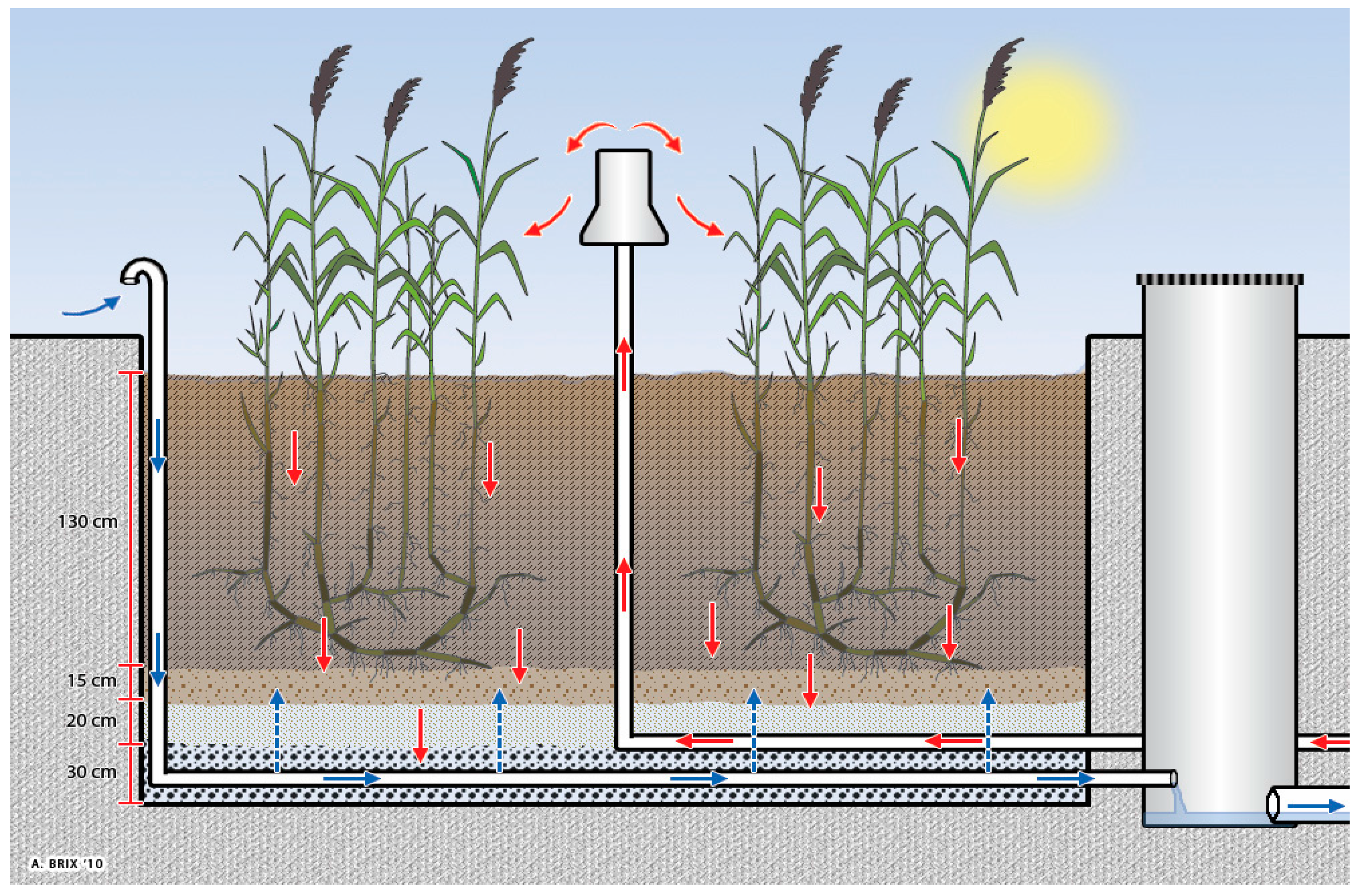
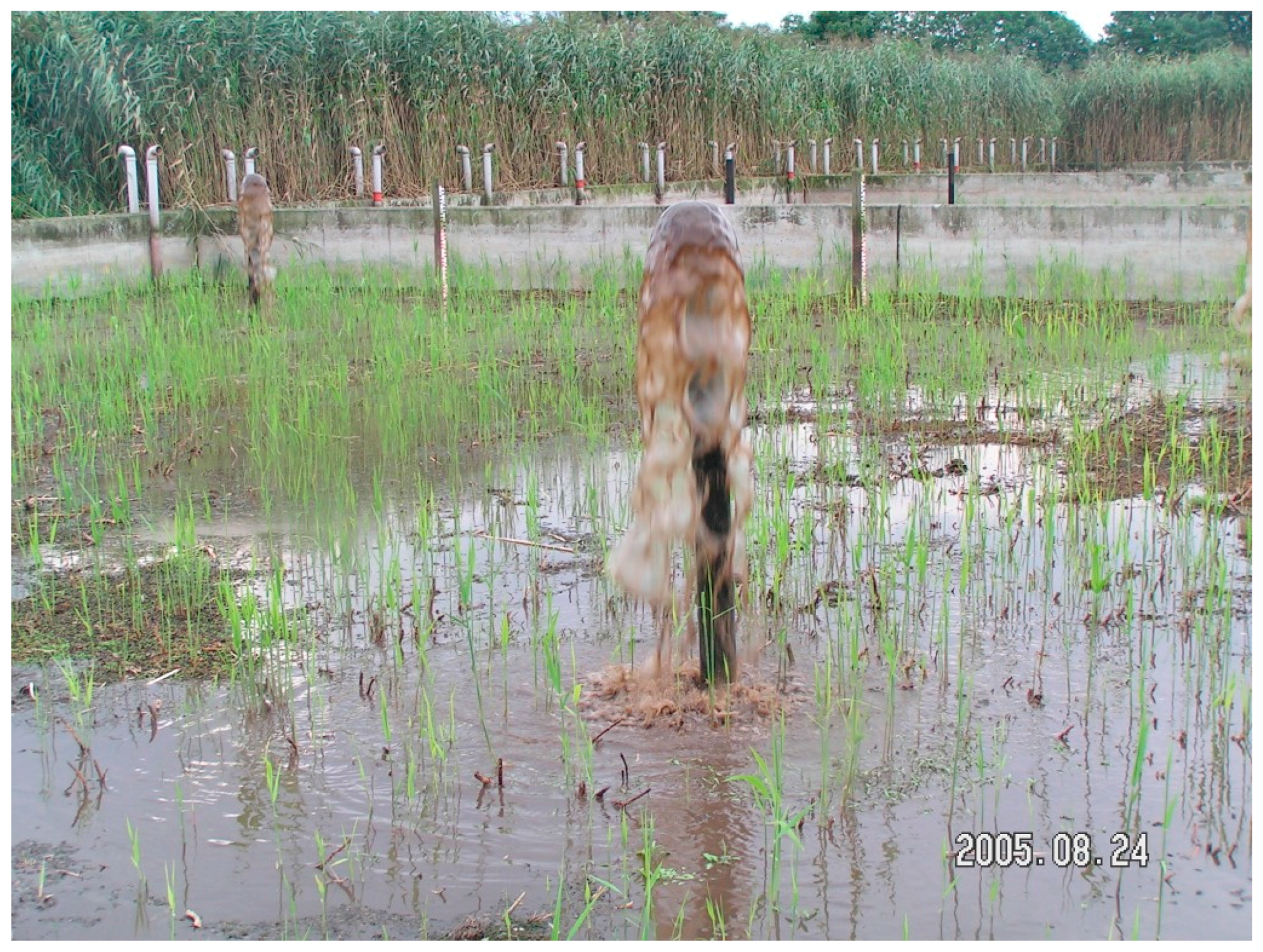
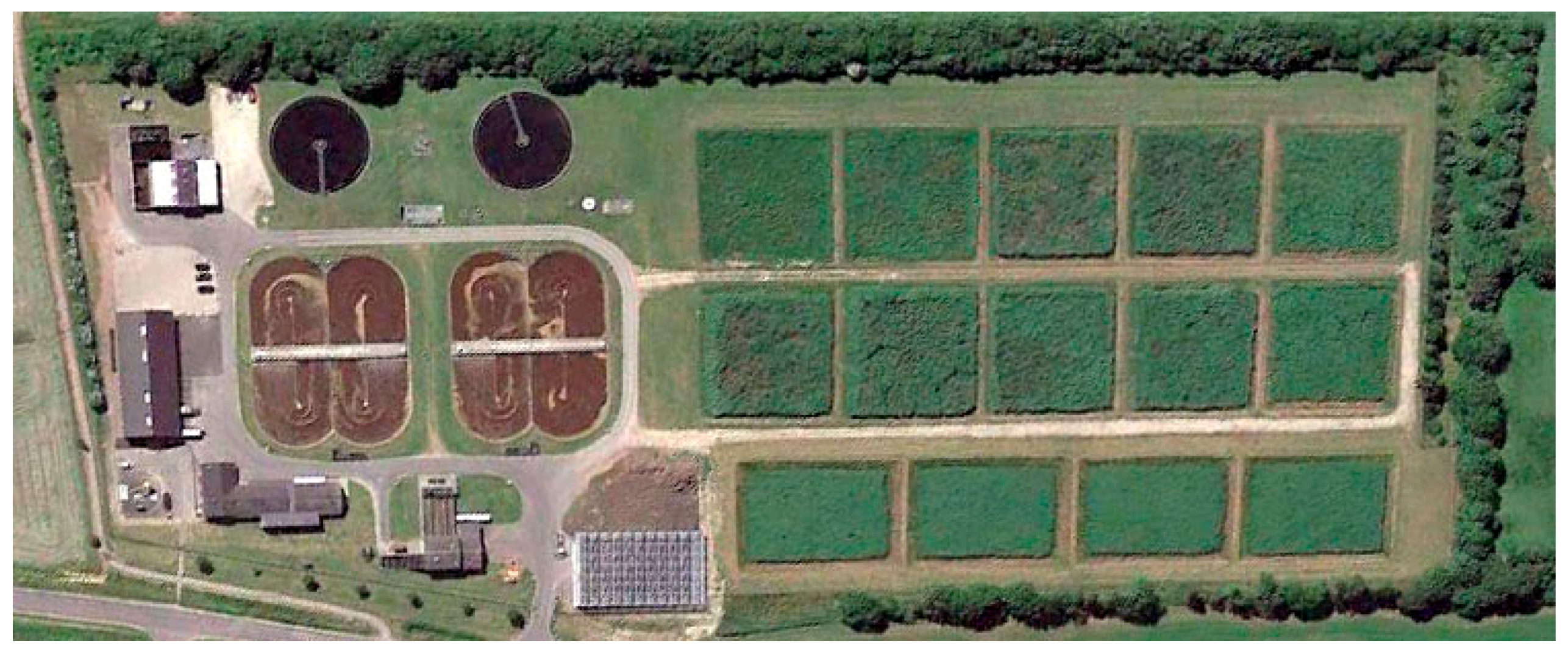
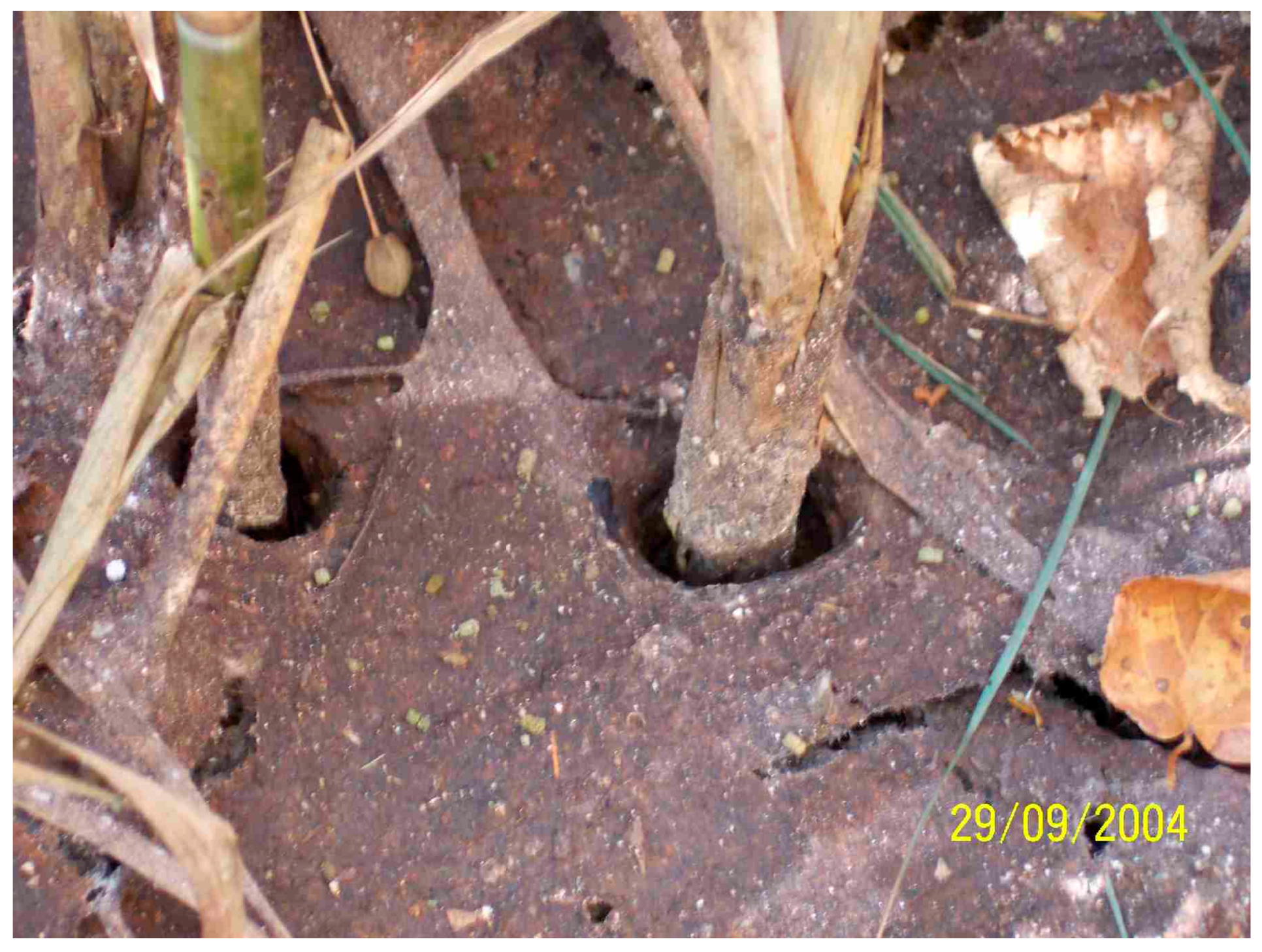
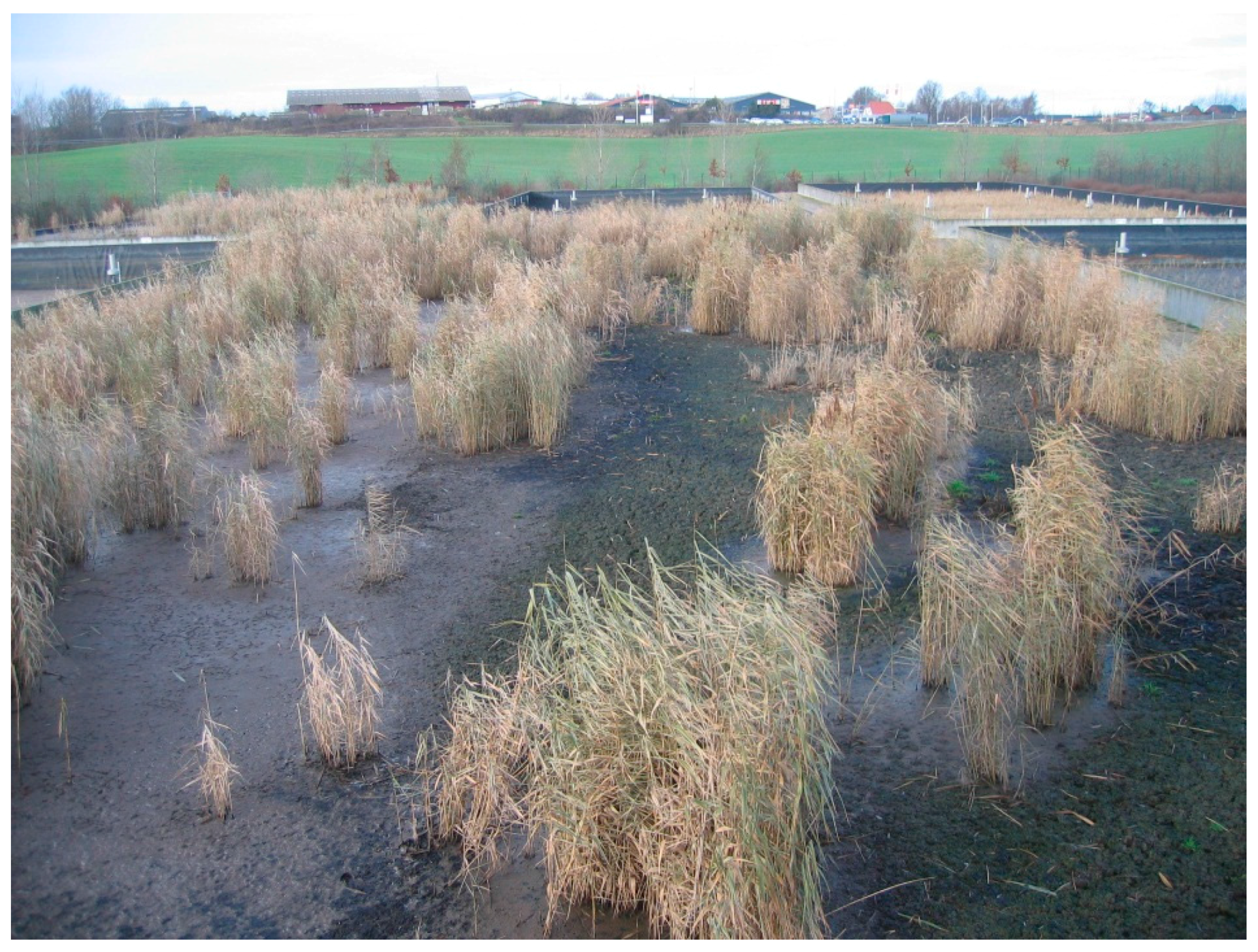
© 2017 by the author. Licensee MDPI, Basel, Switzerland. This article is an open access article distributed under the terms and conditions of the Creative Commons Attribution (CC BY) license ( http://creativecommons.org/licenses/by/4.0/).
Share and Cite
Brix, H. Sludge Dewatering and Mineralization in Sludge Treatment Reed Beds. Water 2017, 9, 160. https://doi.org/10.3390/w9030160
Brix H. Sludge Dewatering and Mineralization in Sludge Treatment Reed Beds. Water. 2017; 9(3):160. https://doi.org/10.3390/w9030160
Chicago/Turabian StyleBrix, Hans. 2017. "Sludge Dewatering and Mineralization in Sludge Treatment Reed Beds" Water 9, no. 3: 160. https://doi.org/10.3390/w9030160
APA StyleBrix, H. (2017). Sludge Dewatering and Mineralization in Sludge Treatment Reed Beds. Water, 9(3), 160. https://doi.org/10.3390/w9030160





